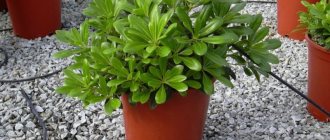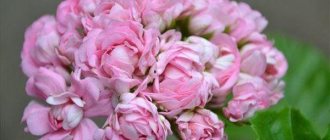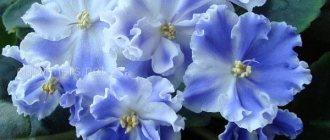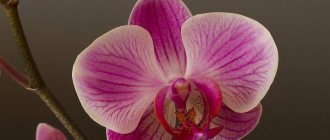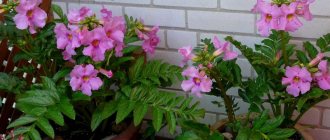Botanical description
Anthurium is popularly called “male happiness” because of beliefs associated with its effect on men’s health. In European countries, the plant is given the name “flamingo flower” because of the red or pink color of the bract, characteristic of many anthuriums, but it is also applied to varieties with white flowers. The Latin name – Anthurium – is derived from the Greek words meaning “flower” and “tail”.
Europeans were introduced to anthurium by the French botanist and landscape architect E.F. Andre. In 1876, he made a scientific expedition to Ecuador, where he discovered a previously unknown plant and sent a copy of it to Europe.
The genus Anthurium belongs to the Araceae family. According to various estimates, it includes from 500 to more than 900 species. Most anthuriums are evergreen herbaceous plants with thick, short stems. The shape and structure of the leaves vary depending on the species. Small square or diamond-shaped flowers are collected in an inflorescence-cob with a leathery bract of various colors - from white to bright red. People far from botany usually mistake a bract for a single petal of a flower . Natural habitat is from Mexico to northern Argentina.
Decorative deciduous species of anthuriums
The variety of shapes of its leaves is also surprising. They can be solid, dissected, heart-shaped, rounded or oval, long and short, with a matte surface or glossy. The veins on the surface of the leaves form fantastic patterns and amaze with their beauty no less than the flowers.
Three varieties of decorative foliage are usually grown: Crystal anthurium, Majestic anthurium and Dissected anthurium.
Anthurium Crystal
Anthurium Crystal
Anthurium Crystal has deep green leaves. Their shape resembles a large heart, and their surface is a velvety blanket of crystal luster with silver veins. Well, this anthurium has very beautiful leaves! But it blooms as an inconspicuous flower with a small veil up to 10 cm in length and a tiny 2 cm spadix of purple color. Therefore, this type of anthurium is bred exclusively as an ornamental foliage plant.
Anthurium Majestic
Anthurium Majestic
Anthurium Majestic is an ornamental foliage plant. It is similar to Anthurium Crystal in the color of its leaves. It grows very quickly. Large velvety leaves grow in enormous sizes - up to 40 cm in diameter, and have a pointed tip. Bright white veins appear on the green, less often purple, surface of the leaves in a unique pattern.
Anthurium dissected
Anthurium dissected
Anthurium dissected has large green leaves of an unusual, dissected shape with wavy edges. Its cover is cream-colored, its inflorescence is beige-green.
Anthurium climbing
Anthurium climbing
Anthurium climbing is a green vine. Grows more than 1 meter in length. The leaves are leathery to the touch. The leaf shape is oval or lanceolate. Small black dots are visible on the underside of the leaves. The peduncle is short, the flower spathe is green, plus an inconspicuous inflorescence. But the berries that grow on this anthurium look more beautiful than the flowers - they are painted in different colors - from white to purple.
Climbing Anthurium Leaf
Baker's Anthurium
Baker's Anthurium
This may be interesting: Types and varieties of Crossandra
Baker's Anthurium is distinguished by its leaves, which look like long straps. The leaves are green on top and have a reddish-brown velvety texture on the reverse side with a large number of barely noticeable lateral veins. They grow up to 55 cm in length and up to 9 cm in width. The peduncle is much shorter, only 10 cm, and the spadix is also cream-colored. The berries are red.
Plant varieties and photos with them
In indoor floriculture, the two most common species are Anthurium Andre and Anthurium Scherzer. For both of these the red bract color is more typical, but there are a number of white cultivars.
Due to its large size, Anthurium Andre is most often grown in greenhouses, but is also suitable for home use. Among the most common varieties are white.
White Champion
White Champion. A variety with a yellowish ear on a high peduncle . The snow-white bract is beautifully curved. Over time, a light green tint appears.
White Heart
White Heart. The ear of this variety is bright pink with a more intense color closer to the tip, the bract is white and pointed.
Acropolis (Acropolis)
Acropolis (Acropolis). The spadix is light yellow at the base, with a bright yellow tip reminiscent of a candle flame. The bract is snow-white, the shape is close to round. This variety is characterized by large leaves .
Polaris (North Star)
Polaris (Polar Star). The cob is white, acquiring a pinkish tint over time. The bract - elongated, pointed, with beautiful curves - resembles a ray of a star. As it blooms it turns greenish.
Scherzer
Anthurium Scherzer is more suitable for rooms and offices . A distinctive feature is the cob, slightly twisted in a spiral. Among the white varieties, the most famous is Album with a white cob and a white oval bract. Scherzer anthurium varieties are described here.
What colors are anthuriums?
Today there are many varieties of anthuriums. They all differ in the color of the bedspread.
White
The most popular white plant varieties include Champion White and Sumi. There is also an interesting white and pink culture - Anthurium Amalia Elegance.
Pastel colors - pink and peach
Popular pink varieties include Joli, Pink Champion, Lady Love. Also, such varieties of anthurium with pink variegation as Picasso Pink and Pink Queen are very popular among flower growers.
Reds
The most popular red species include Dakota, Turenza. Red-green crops, in particular Baby Boom, look interesting.
Purple and lilac
Anthurium violet is rapidly gaining its popularity. One of the most common varieties is Tulip. Fiorino also belongs to the lilac anthuriums. It is characterized by an unusual coverlet. You can also grow the Cavalli variety.
Plants with purple flowers look beautiful
Ultramarine
Today there are many varieties on sale with an amazing ultramarine color. These include the anthurium varieties Picasso and Princess Alexia.
Blue and blue
There are quite a few painted plants that are striking in the color of their flowers. Scientists managed to obtain unusual blue shades of anthuriums by introducing dyes into the roots of the culture. Blue anthuriums are obtained in the same way.
Yellow and orange
Orange anthurium varieties include Picasso Orange, Princess Orange. Orange-red varieties look impressive - Madural Orange, Baby Orange.
Note! The orange anthurium Rainbow Champion looks attractive. If you want to grow a beautiful yellow anthurium, you should pay attention to the Vanilla variety
Greens
Popular varieties of green anthurium include Baby Green, Midori. An equally impressive option would be Green King or Picasso Green.
Dark - black, chocolate, brown
The original varieties of flowers include dark varieties. This category includes black, brown, burgundy anthuriums. Popular varieties from this group include Black Queen, BlackBeauty, Otazu. An interesting option is the Black Prince.
Home care
- Temperature . Like most tropical plants, anthurium is thermophilic. In the summer, it requires a temperature of 20 to 27 °C; in the winter-autumn period it is reduced to 15 °C, but this must be done gradually. The flower does not tolerate drafts. From mid-January, you should start raising the temperature and gradually bring it to summer temperature.
- Watering .
Anthurium, a native of rain forests, loves moisture very much, but does not tolerate stagnant liquid. It would be ideal if there was an aquarium close to the flower. It needs to be watered abundantly, especially in summer. Before watering, you need to make sure that the top layer of soil has had time to dry, but the soil in the pot should not be allowed to dry out completely. Water for irrigation should be at room temperature, you need to let it settle. Lime water should be softened. After watering, the water from the pan must be drained. - Light . Anthurium does not tolerate direct sunlight. It is preferable to place it on eastern and western window sills. If the window faces south, the flower needs to be shaded.
- Soil . Ready-made soil for orchids is perfect for anthurium. The soil should be slightly acidic or neutral. You can prepare the mixture yourself by combining leaf soil and peat in equal proportions. Some gardeners advise mixing the bark with a small amount of sphagnum, peat and charcoal, and also adding some pine needles and brick chips. The soil must be well permeable to air and moisture.
- Trimming. Pruning is necessary if the bush is too bushy or if there are discolored leaves or leaves with white spots. Do not use garden shears that are too large. Secateurs work well.
- Trimming starts from the top. Dried leaves and branches, as well as discolored leaves, are removed. Pruning is done at an angle downwards.
- After pruning until healing, the plant is sprayed with water from a spray bottle.
Feeding .
Liquid fertilizers for flowering plants are used for feeding. The solution should be weak (20% of the dose recommended by the manufacturer). Anthurium should be fertilized no more than once a month, otherwise the leaves will begin to grow without forming buds. Once every 3-4 months you can feed the anthurium with Epsom salt at a concentration of 1-2 tablespoons per 4.5 liters of water. The solution is prepared immediately before watering. At the end of summer, feeding is gradually reduced; in the autumn-winter period, anthurium is not fed.- Pot . The pot must match the size of the earthen ball. In a clay pot, the soil dries out faster; a plastic pot allows you to maintain the required level of substrate moisture. It is desirable that the pot has large drainage holes. A rim-stand along the bottom edge will provide air access to the roots. Under no circumstances should pots be used.
- Transfer. Young plants are replanted annually, then as needed. The main criterion is that the flower becomes cramped in the pot. You should not replant a newly purchased plant - it must get used to the new conditions.
- Before transplanting, a drainage layer (for example, expanded clay) is placed on the bottom of the new pot, and coconut fiber or sphagnum is used as the second layer.
- Next, the main soil is filled in.
- The plant is removed from the pot, the fragile roots are carefully cleared of soil (it is advisable to rinse them under running water), and checked for rot.
- A healthy plant is transplanted into a prepared pot.
- Wintering . Winter for anthurium is a period of rest. During this time, it is kept at a temperature of about 15 ° C, watered no more than once a week and not fed.
Some gardeners also advise laying a layer of sphagnum on the soil surface.
Signs and superstitions
The popular name of anthurium – “male happiness” – is associated with the belief that the flower protects peace in the newlyweds’ family and brings them good luck. That is why in Colombia it is customary to give this plant to a young couple during their wedding. The flower reminds men that they are protectors of their loved ones. A gifted plant gives its owner vitality and positive energy.
Anthurium also has a “second half” - a related plant, somewhat similar in appearance - spathiphyllum, which is often called “women’s happiness”.
They look great together: a gentle and modest spathiphyllum with a white swallowtail inflorescence, and its colorful antipode, the flower of which resembles a fiery heart pierced by an arrow. When located nearby, plants symbolize harmony in the family and protect love.
Legends, beliefs and the Taoist practice of Feng Shui allow you to look at flowers in a new way, to endow them with human or magical properties. Those who claim that the source of happiness for a person is himself are right, and caring for plants brings out his best qualities in the owner. In this sense, any flower has reflected magic, which ultimately belongs to the person himself.
If you are planning to bring to life the idea of “plant harmony” and plant anthurium and spathiphyllum in one pot, then first decide why you need it. These plants are close from a botanical point of view and require approximately the same conditions. However, there are differences between them: anthurium is an epiphyte, spathiphyllum is a terrestrial inhabitant, living near rivers and swamps, so it requires more water when watering, which anthurium does not like.
Take note: the experience of gardeners who planted both plants in the same pot often turned out to be negative: the spathiphyllum grew faster and prevented the first from developing.
If you need “male and female happiness” to meet, just place the plants closer to each other.
Reproduction
Anthurium is propagated by dividing the bush, seeds, shoots and cuttings.
If dividing the bush is used, then when transplanting the flower is divided into several small bushes, which are planted in separate pots.- Seed propagation is more labor-intensive. The seeds are removed from the ripened fruits and the remaining pulp is removed. Having disinfected the seeds in a solution of potassium permanganate, they are laid out on the surface of leaf or peat soil. Germination requires a temperature of at least 22-24 °C. Seeds germinate in 8-15 days. After 1.5 months, in the true leaf phase, picking is done.
- For propagation, you can also use apical cuttings that are rooted in damp sand.
- Side shoots with aerial roots are planted directly into the pot.
How to propagate anthurium
Obtaining new plants is possible through children, dividing the bush, cuttings, and seeds.
The first two methods are used in the spring during annual transplantation. The roots are separated with a sharp knife, dusting the cut areas with crushed coal. Water the transplanted plants carefully, trying not to flood them.
Cuttings are carried out after pruning:
- The cuttings are placed in a container with perlite and sand.
- Cover with a glass cap.
- Keep at +22…+24 °C, constantly moisturize and ventilate.
Seed propagation is mainly used by breeders to develop new varieties.
At home, this is a long and complex method:
- They pollinate the flower on their own (with the help of a brush, pollen is transferred from the stamens to the stigmas of the pistils).
- Wait until the berries ripen (8 months).
- Seeds are taken out of them and washed.
- Sow in containers with a light substrate and a thin layer of perlite.
- Then they are cared for, just like when cuttings. As the seedlings grow, they move into larger pots.
- A plant grown in this way may bloom weakly in the second year; full flowering will occur only after 4-5 years.
Diseases and pests
Anthurium is susceptible:
- Fungal diseases such as anthracnose, septoria, as well as parasites - mealybugs, thrips, aphids. To destroy them, special fungicides and insecticides are used.
- Also, at low temperatures and a lack of microelements, the leaves may curl and wrinkle.
Among the variety of species and varieties of anthuriums, it is difficult to choose the right plant for yourself. To make the choice easier, we have prepared materials for information about Anthurium Black, including Black Queen (Black Prince), Dakota, Cavalli, Hooker, Utah, as well as pink and crystal.
Similar plants
- Calla, or calla lily, also belongs to the Araceae family. Unlike anthurium, whitewing tolerates northern climates well. In Russia, it can often be found in swamps, in ditches with standing water. The inflorescence in appearance and structure resembles an anthurium; its bract is always white.
- Zantedeschia is a close relative of the whitewing, previously included in the same genus with it. Comes from Africa.
- Callopsis, another plant from the Araceae family. A characteristic feature is a short cob.
- Anaphyllum also belongs to the Araceae family. Originates from the tropical forests of South India. The structure of the inflorescence is close to anthurium, but the bract is purple in color and spiral-shaped.
- Spathiphyllum, another member of the Araceae family, closely resembles anthurium. Its spadix is larger, the bract is always white, and turns green over time. Originally from Central and South America, it is also found in Oceania. Like anthurium, it is used in indoor floriculture.
Anthurium with surprisingly graceful white flowers is an excellent choice for a gardener . The contrasting combination of several varieties looks especially impressive. If you place it next to red or orange, they will perfectly complement and highlight each other’s advantages.



